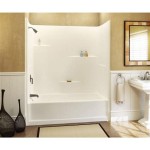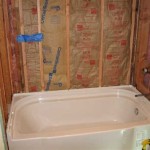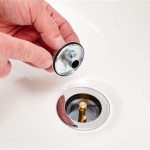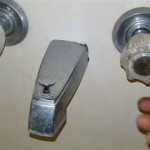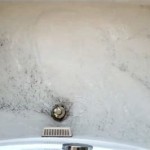Best Material For Bathtub Walls: A Comprehensive Guide
Selecting the appropriate material for bathtub walls is a crucial decision in bathroom renovation or new construction projects. The bathtub wall is a high-moisture environment, which necessitates a material that is not only aesthetically pleasing but also durable, water-resistant, and easy to maintain. Several options are available, each with its advantages and disadvantages. This article presents a detailed examination of the most common materials used for bathtub walls, outlining their properties and suitability for different needs and budgets.
Acrylic
Acrylic is a popular choice for bathtub walls due to its non-porous nature and relatively low cost. It is a type of plastic that is thermoformed into sheets and then reinforced with fiberglass for added strength and rigidity. This construction method provides a durable and lightweight material that is resistant to cracks and chips. Acrylic surfaces are also easy to clean and maintain, requiring only mild soap and water.
One of the primary advantages of acrylic is its ability to retain heat, making it a comfortable surface to lean against during a bath. Additionally, acrylic comes in a wide range of colors and designs, offering flexibility in achieving the desired aesthetic. It can also be molded to create integrated shelves and niches, enhancing functionality.
However, acrylic is not without its drawbacks. While resistant to scratches, it can be susceptible to damage from abrasive cleaners. Also, while it is considered durable, it is not as robust as some of the other materials available, and can be prone to scratching if not cleaned properly. Its lifespan, while respectable, is generally shorter than natural stone or porcelain.
The installation process for acrylic is straightforward, with prefabricated panels often used for ease and speed. This can reduce labor costs compared to more complex materials. Acrylic is also a good choice for those looking for a seamless look, as panels can be installed with minimal grout lines.
Tile (Ceramic and Porcelain)
Tile, particularly ceramic and porcelain, is a classic and enduring choice for bathtub walls. These materials are known for their exceptional durability, water resistance, and aesthetic versatility. Ceramic tile is made from clay that is fired at high temperatures, while porcelain tile is a denser and more durable type of ceramic made from a finer clay and fired at even higher temperatures.
A key benefit of tile is its resistance to water and stains. When properly installed with grout, tile creates a waterproof barrier that protects the underlying wall structure from moisture damage. Porcelain tile is particularly impervious to water, making it an ideal choice for high-moisture environments.
Tile offers a vast array of colors, sizes, shapes, and textures, allowing for virtually limitless design possibilities. From classic subway tile to intricate mosaic patterns, tile can be customized to suit any style. It is also possible to create unique designs by mixing different tile types and colors.
The primary disadvantage of tile is the grout lines. Grout is porous and can be susceptible to staining and mildew growth. Regular cleaning and sealing are necessary to maintain the appearance and integrity of the grout. Epoxy grout is a more expensive but more resistant option to standard cementitious grout, providing better stain and water resistance.
Installation of tile is a more labor-intensive process compared to acrylic or fiberglass. It requires careful preparation of the substrate, precise cutting and placement of the tiles, and proper grouting and sealing. This can result in higher labor costs. However, the longevity and aesthetic appeal of tile often justify the investment.
Fiberglass
Fiberglass is another cost-effective option for bathtub walls. It is made by reinforcing plastic with glass fibers, creating a relatively lightweight and durable material. Fiberglass is often available in prefabricated panels, making installation quick and easy.
The affordability of fiberglass is a major advantage. It is typically less expensive than acrylic, tile, or natural stone. It is also relatively easy to clean and maintain, requiring only mild soap and water. Fiberglass is also resistant to mold and mildew growth.
However, fiberglass is not as durable as other materials. It is susceptible to scratches and dents, and its color can fade over time. While it can be repaired, the repairs may not be seamless and can be visible. Fiberglass also has a less luxurious appearance than other materials like acrylic or tile.
The installation of fiberglass panels is relatively straightforward, which can help reduce labor costs. However, the panels may not fit perfectly in all bathrooms, and some customization may be required. Fiberglass is a suitable option for budget-conscious homeowners who are looking for a low-maintenance and easy-to-install bathtub wall material.
Over time, because of its relatively thin layer of coating over fiberglass, small cracks can form, making cleaning more difficult. Also, because it is not as rigid as acrylic, it is more likely to flex, which can lead to stress fractures over the long term.
Natural Stone (Granite, Marble, and Slate)
Natural stone, such as granite, marble, and slate, represents a premium option for bathtub walls. These materials are known for their exceptional beauty, durability, and luxurious appeal. Each type of stone has unique characteristics that contribute to its distinct aesthetic.
Granite is a hard and durable stone that is highly resistant to scratches, stains, and heat. It comes in a wide range of colors and patterns, offering a unique and natural look. Marble is a softer stone that is known for its elegant veining and polished finish. Slate is a fine-grained, metamorphic rock that is known for its natural cleft and rustic appearance.
The primary advantage of natural stone is its aesthetic appeal. Each slab of stone is unique, with variations in color, pattern, and texture that add character and visual interest to the bathroom. Natural stone can create a luxurious and spa-like atmosphere.
However, natural stone is a more expensive option compared to other materials. The cost of the stone itself, as well as the labor required for installation, can be significantly higher. Natural stone also requires regular sealing to protect against stains and water damage. Some stones, like marble, are more porous and prone to staining than others.
The installation of natural stone is a complex and labor-intensive process. It requires skilled craftsmen who can properly cut, shape, and install the stone. The substrate must be carefully prepared to ensure that the stone is properly supported. Natural stone is a suitable option for homeowners who are willing to invest in a premium material that will add lasting value to their home.
Solid Surface
Solid surface materials, such as Corian and Swanstone, are synthetic materials made from a blend of minerals and acrylic or polyester resins. These materials offer a seamless and non-porous surface that is highly resistant to stains, scratches, and mold growth.
One of the key benefits of solid surface is its seamless appearance. The material can be fabricated and installed with virtually invisible seams, creating a smooth and continuous surface. This eliminates the need for grout lines, which can be a source of staining and mildew growth.
Solid surface is also highly versatile. It can be molded into a variety of shapes and designs, allowing for customized features such as integrated sinks, shelves, and niches. It is available in a wide range of colors and patterns, mimicking the look of natural stone or other materials.
While solid surface is durable, it is not as scratch-resistant as natural stone. It can be susceptible to damage from abrasive cleaners and sharp objects. However, scratches can often be buffed out or repaired. Solid surface is also a relatively expensive option compared to acrylic or fiberglass.
The installation of solid surface requires specialized tools and techniques. It is typically installed by trained professionals who can ensure a seamless and watertight installation. Solid surface is a suitable option for homeowners who are looking for a durable, low-maintenance, and aesthetically pleasing bathtub wall material.
Glass
Glass is an increasingly popular material choice for bathtub walls for its sleek aesthetics and ease of maintenance. Typically used in the form of tempered glass panels, it provides a modern and minimalist look while offering excellent water resistance.
One significant advantage of glass is its non-porous nature. This feature prevents water absorption and makes it highly resistant to mold and mildew growth. Cleaning becomes effortless, usually requiring only a squeegee or a simple wipe-down with a mild cleaning solution.
Glass also enhances the feeling of space within a bathroom due to its transparency. It allows light to pass through freely, making the room appear brighter and more open. Glass panels can be customized in various ways, including etching, frosting, or tinting, to provide privacy or add decorative elements.
However, glass also has its drawbacks. It can be expensive, especially when considering custom cuts and treatments. It also requires meticulous installation to prevent leaks and ensure structural integrity. Moreover, while tempered glass is durable, it can still be prone to shattering if subjected to strong impacts.
The maintenance of glass bathtub walls includes regular cleaning to avoid water spots and soap scum buildup. Also, hard water can leave noticeable streaks, so using a water softener system may be beneficial. Installation often involves professional services, which may increase the project's overall cost.
Choosing the Right Material
Selecting the best material for bathtub walls involves considering several factors, including budget, aesthetic preferences, durability requirements, and maintenance considerations. Acrylic and fiberglass offer affordable and easy-to-install options, while tile, solid surface, and natural stone provide greater durability and aesthetic appeal. Glass offers a modern look with easy maintenance, but can be costly.
Before making a final decision, it is advisable to research different materials, compare prices, and consult with a qualified contractor to ensure that the chosen material is suitable for the specific bathroom layout and needs. Proper installation is essential for ensuring the longevity and performance of the bathtub wall.
Ultimately, the ideal material for bathtub walls will depend on the individual homeowner's priorities and the specific requirements of the bathroom. By carefully weighing the pros and cons of each material, it is possible to choose a bathtub wall that is both functional and aesthetically pleasing.

Comprehensive Guide To The Best Shower Wall Materials

Best Shower Wall Materials Tile Alternatives For Your Bathroom Bathfitter

The Best Materials For Your Bathtub Shower Combo

Best Shower Wall Materials Tile Alternatives For Your Bathroom Bathfitter

The Best Materials For Your Bathtub Shower Combo

What Is The Best Bathtub Material And How To Choose Giving Tree

Bathtub Guide And Surrounds Make It Right

Comprehensive Guide To The Best Shower Wall Materials

The Best Materials For Your Bathtub Shower Combo

The Best Shower Wall Material Ideas 6 Options To Transform Your Bathroom Arinsolangeathome
Related Posts

